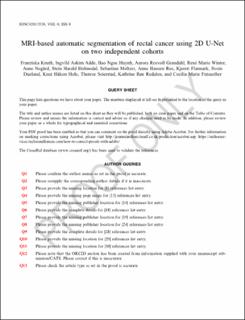| dc.contributor.author | Knuth, Franziska Hanna | |
| dc.contributor.author | Adde, Ingvild Askim | |
| dc.contributor.author | Huynh, Bao Ngoc | |
| dc.contributor.author | Grøndahl, Aurora Rosvoll | |
| dc.contributor.author | Winter, René | |
| dc.contributor.author | Negård, Anne | |
| dc.contributor.author | Holmedal, Stein Harald | |
| dc.contributor.author | Meltzer, Sebastian | |
| dc.contributor.author | Ree, Anne Hansen | |
| dc.contributor.author | Flatmark, Kjersti | |
| dc.contributor.author | Dueland, Svein | |
| dc.contributor.author | Hole, Knut Håkon | |
| dc.contributor.author | Seierstad, Therese | |
| dc.contributor.author | Redalen, Kathrine | |
| dc.contributor.author | Futsæther, Cecilia Marie | |
| dc.date.accessioned | 2022-04-05T07:25:53Z | |
| dc.date.available | 2022-04-05T07:25:53Z | |
| dc.date.created | 2022-01-17T11:17:20Z | |
| dc.date.issued | 2021 | |
| dc.identifier.citation | Acta Oncologica. 2021, 1-9. | en_US |
| dc.identifier.issn | 0284-186X | |
| dc.identifier.uri | https://hdl.handle.net/11250/2989775 | |
| dc.description.abstract | Background
Tumor delineation is time- and labor-intensive and prone to inter- and intraobserver variations. Magnetic resonance imaging (MRI) provides good soft tissue contrast, and functional MRI captures tissue properties that may be valuable for tumor delineation. We explored MRI-based automatic segmentation of rectal cancer using a deep learning (DL) approach. We first investigated potential improvements when including both anatomical T2-weighted (T2w) MRI and diffusion-weighted MR images (DWI). Secondly, we investigated generalizability by including a second, independent cohort.
Material and methods
Two cohorts of rectal cancer patients (C1 and C2) from different hospitals with 109 and 83 patients, respectively, were subject to 1.5 T MRI at baseline. T2w images were acquired for both cohorts and DWI (b-value of 500 s/mm2) for patients in C1. Tumors were manually delineated by three radiologists (two in C1, one in C2). A 2D U-Net was trained on T2w and T2w + DWI. Optimal parameters for image pre-processing and training were identified on C1 using five-fold cross-validation and patient Dice similarity coefficient (DSCp) as performance measure. The optimized models were evaluated on a C1 hold-out test set and the generalizability was investigated using C2.
Results
For cohort C1, the T2w model resulted in a median DSCp of 0.77 on the test set. Inclusion of DWI did not further improve the performance (DSCp 0.76). The T2w-based model trained on C1 and applied to C2 achieved a DSCp of 0.59.
Conclusion
T2w MR-based DL models demonstrated high performance for automatic tumor segmentation, at the same level as published data on interobserver variation. DWI did not improve results further. Using DL models on unseen cohorts requires caution, and one cannot expect the same performance. | en_US |
| dc.language.iso | eng | en_US |
| dc.publisher | Taylor & Francis | en_US |
| dc.title | MRI-based automatic segmentation of rectal cancer using 2D U-Net on two independent cohorts | en_US |
| dc.type | Peer reviewed | en_US |
| dc.type | Journal article | en_US |
| dc.description.version | acceptedVersion | en_US |
| dc.rights.holder | This is the authors' accepted manuscript to an article published by Taylor & Francis. Locked until 17.12.2022 due to copyright restrictions. | en_US |
| dc.subject.nsi | VDP::Fysikk: 430 | en_US |
| dc.subject.nsi | VDP::Physics: 430 | en_US |
| dc.source.pagenumber | 1-9 | en_US |
| dc.source.journal | Acta Oncologica | en_US |
| dc.identifier.doi | 10.1080/0284186X.2021.2013530 | |
| dc.identifier.cristin | 1982383 | |
| dc.relation.project | Kreftforeningen: 198116-2018 | en_US |
| cristin.ispublished | true | |
| cristin.fulltext | postprint | |
| cristin.qualitycode | 1 | |
